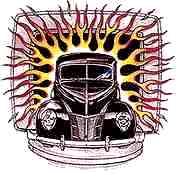

The home of Australian Hot Rodding on the Net
Step 5: ChassisThe foundation of your project, chassis building is a very important stage of your project. Remember every modification will require engineers certification for registration. So you need to plan and design what you intend to do. If you don't follow anything else out of all of this there is one golden rule. Get your chassis/suspension finished first, then start work on the body. OriginalMost original chassis are by their very nature severely lacking in the structural requirements for a modern hot rod. They are typically 50 to 70 years old and have been subjected to the ravages of nature, pitted and rusted. Most will require considerable repairs and reinforcement in the form of boxing to withstand the forces of modern V8 motors. Plus with the changes to front and rear suspension systems and power trains, there will be numerous bracket and holes to be removed, replaced or filled. Given all these changes it is common practice to replace front, rear and internal cross members. So at the end of the day you actually end up with very little of the original chassis left. Replacement RailsThere are now a number of manufacturers of replacement or new chassis rails. The construction of these varies considerably as does their similarity to the original product and this will all effect their suitability for your project. Some manufacturers have gone to the trouble and expense of pressing the rails, this is the same manufacturing technique as the originals and say for '32 rails give the opportunity to include the reveal in the side of the rail. This produces a "C" section. Other manufacturers will build their rails out of 2 individual pieces of plate steel, cut to shape and then welded into the familiar "C" section. Or with a fourth section completely boxed. Donor ChassisSome body styles will take a chassis swap very well. For example there are now a couple of Australian body makers offering Toyota Hi-lux chassis with the correct mounting points. Pick ups like the F100 often ride on a Holden 1 tonner chassis. Cross membersThe hot rod chassis obtains most of is strength and rigidity from the center crossmember. As well they usually provide a rear mounting point for the transmission. Early hot rod cross members were constructed of similar section to the original chassis. However the modern configuration uses square or circular tubular sections in a cage design which allow for exhausts and other lines to run through them allowing the rods to sit lower than before. Motor and Transmission MountsRegistrationThis usually has a lot to do with what chassis will be used, as most authorities base the cars origin on the chassis. So if you were to replace the chassis with a new one or do a swap, the rod would then have to comply with all Australian Design Rules from the year of manufacture of that chassis. |
|
Last Updated: 11/08/2002. Copyright © 1996-2004 by
HIGH PERFORMANCE WEB SITES, all rights reserved. All other trademarks, tradenames and/or service marks are the property of their respective holders. Copyright © 1996-2004 Hot-Rod Internet All Rights Reserved. Please read our Disclaimer , Terms and Conditions and Privacy Policy |